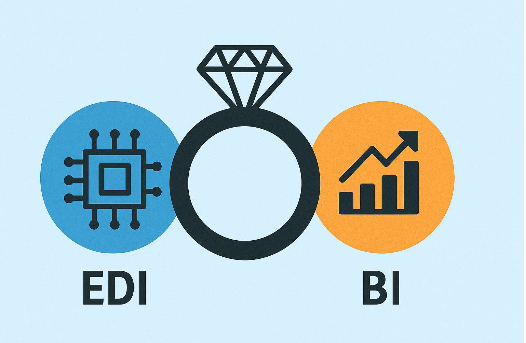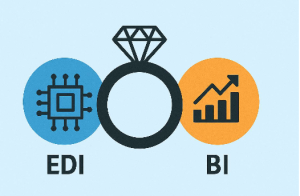
In the world of modern commerce, data is currency—but only if you can use it wisely. While Electronic Data Interchange (EDI) has long powered the machine of B2B transactions, Business Intelligence (BI) has emerged as the brain that makes sense of it all. Together, they’re not just compatable—they’re a perfect match.
If EDI is the nervous system of digital business—automating communication between trading partners—BI is the insight engine that turns that activity into actionable strategy.
1. EDI Captures the Data—BI Tells the Story
EDI efficiently transmits transactional data: purchase orders, invoices, shipping notices, and more. It’s structured, reliable, and high-volume—exactly the kind of data BI tools thrive on.
When you plug BI into your EDI environment, you unlock real-time visibility into things like:
- Which customers are ordering the most and when
- How invoice cycles affect cash flow
- Where bottlenecks in fulfillment might be hiding
- Supplier performance over time
- It’s the difference between data collection and data intelligence.
2. Real-Time Decision-Making
The modern supply chain doesn’t wait. With EDI delivering continuous streams of transactional data, BI dashboards can provide instant insights. That means faster reaction to demand shifts, inventory issues, or pricing anomalies.
Imagine being able to spot a drop in order volume from a key retailer and proactively reach out before it affects the bottom line. Or catching a delay trend in shipments before it becomes a customer service issue.
With EDI + BI, you’re not just reacting—you’re anticipating.
3. Performance Optimization
Want to know which product lines are flying off the shelves—or which ones are collecting dust in a warehouse? Your EDI system has the data. Your BI tools can surface trends, measure KPIs, and help you optimize for profit, efficiency, and customer satisfaction.
Whether you’re a manufacturer, distributor, or retailer, EDI data piped into BI tools can reveal:
- Fill rate accuracy
- On-time delivery rates
- Partner compliance performance
- Forecast vs. actual demand variance
The result? Smarter operations and better business outcomes.
4. BI Brings Context to Raw EDI Data
Let’s face it—raw EDI data isn’t the most user-friendly. It’s built for machines, not marketers. BI platforms translate that structured data into human-readable dashboards, graphs, and KPIs, making it accessible across departments—from sales and finance to operations and executive leadership.
It bridges the gap between your back-end systems and front-line decisions.
5. Scaling with Confidence
As businesses grow and data volumes explode, the EDI + BI duo scales beautifully. EDI keeps handling the transactional load without missing a beat. BI evolves with your questions—drilling deeper, slicing differently, and giving your team confidence in every decision.
It’s the digital foundation for scaling smarter, not just bigger.
The marriage of EDI and BI isn’t just a technology upgrade—it’s a strategic advantage.
EDI tells you what happened. BI tells you what it means—and what to do next.
Together, they empower businesses to move faster, think smarter, and operate more effectively in an increasingly complex and data-driven world


